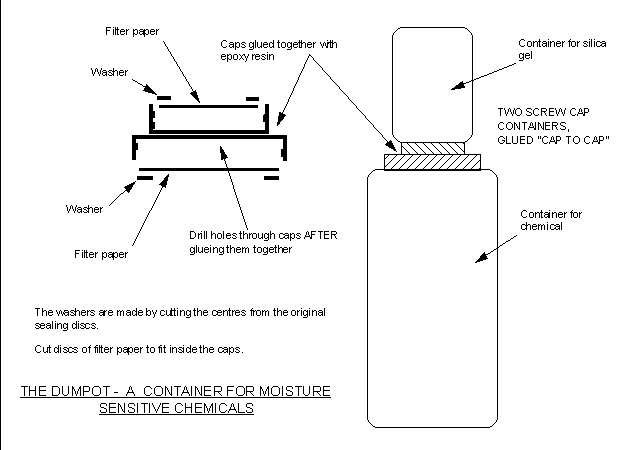Keep Your Powder Dry
John Pearle
Many photographic chemicals are sensitive to moisture. The most obvious is potassium thiocyanate which will turn itself into a solution before your very eyes. This can also mean that when you weigh it out, you are also weighing an indeterminate amount of water. Seasoned weighers and mixers usually are able to avoid this problem by keeping such compounds as solutions. This is not always convenient, for example, when you are making up a working solution, you have to allow for a large amount of added water.
The sketch shows a simple way of keeping such materials dry. Two glass screw cap jars glued together "cap to cap", in a sort of dumbell formation, one containing your precious chemical and the other containing silica gel - hence the Dumpot.
After you have stuck the caps together, cut the centres out of the sealing discs to leave a pair of large washers, one for each cap, take care to get a good neat edge to the hole. Put the washer into the smaller cap, and drill as many holes as you can through the glued surfaces without touching the washer. The idea is to give as large an area of hole as possible whilst providing support for the disc of filter paper which keeps the chemical (or the silica gel) out of the holes but allows water to pass from the chemical half of the pot to the silica gel side. Cut a disc of filter paper (I use Whatman no1 simply because I've got a packet - it needs to be as "coarse" as possible but no free fibres) to be a good fit inside each cap. The washer must cover any irregularities in the disc edge.
The details of the jars will probably be determined more by what you have to hand than anything else, I use 4oz polycarbonate ones for the silica (originally from Rayco) and 250 or 500 g jars for the chemicals. Use the smallest size that you can get away with so that you are drying as little air as possible. Remember that each time you open the jar you need to dry another jarful of air. Glass is best but even polyethylene (which lets a little water vapour through) will work well. Use some indicating grade silica gel so that you can change it when necessary. By unscrewing one half or the other you can get to the chemical or change the gel, and it is a lot less messy than keeping small containers of gel inside the chemical jar. Keep a couple of original caps to temporarily seal the jars while you do this.
So, to keep your powder dry - use a Dumpot. Now, what happened to that job application I'm going to send to NASA.....
